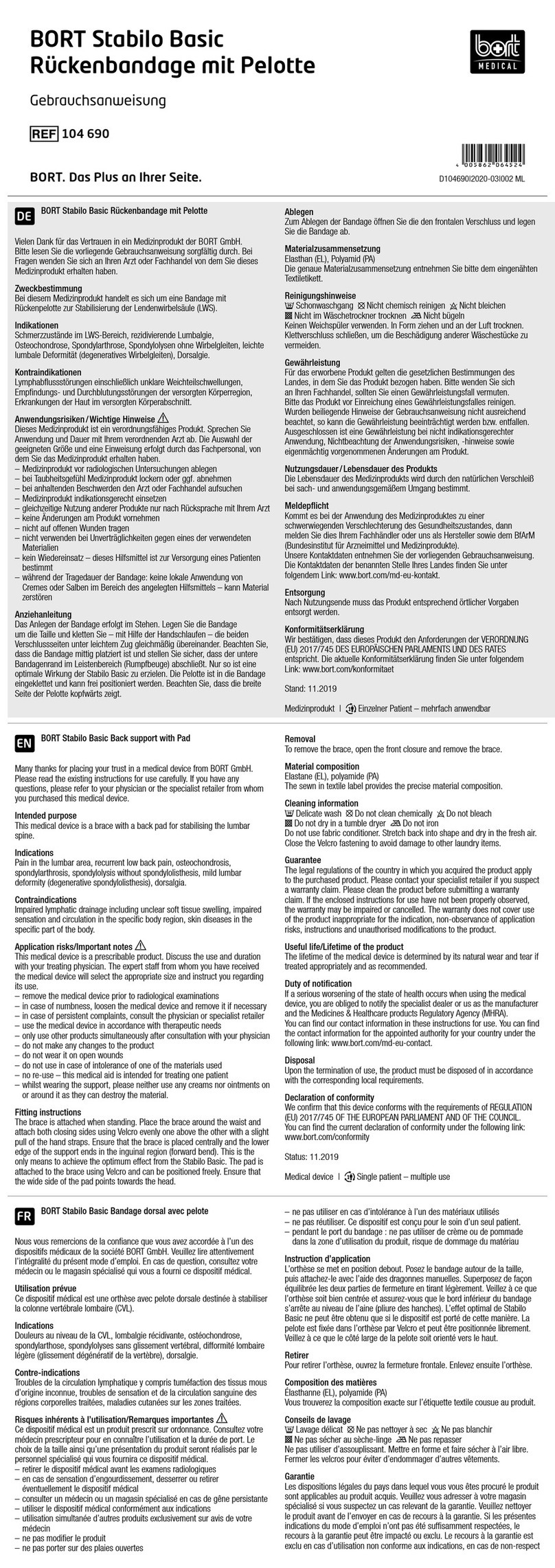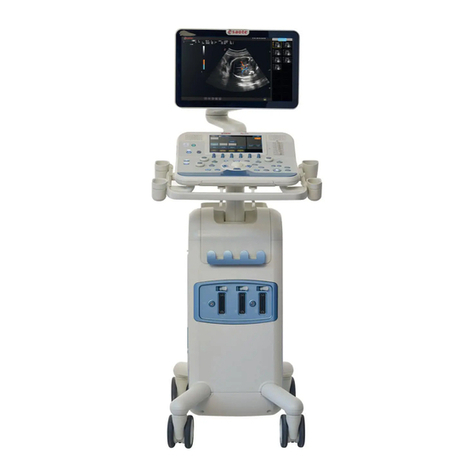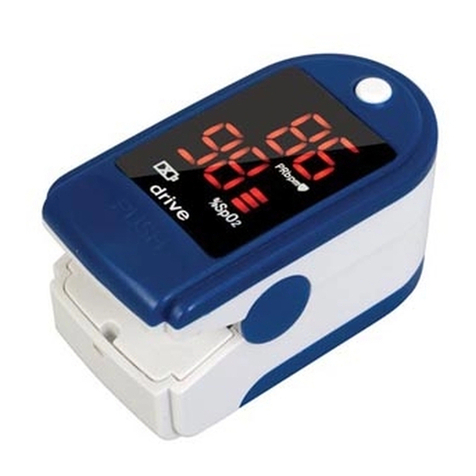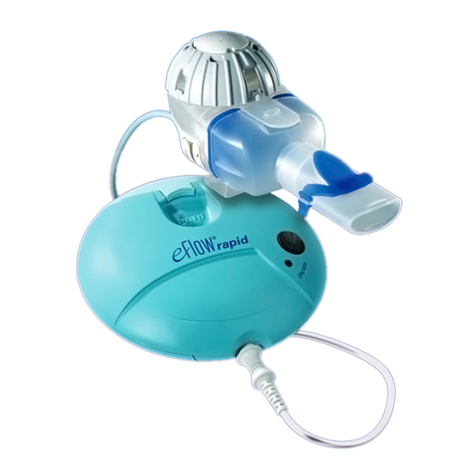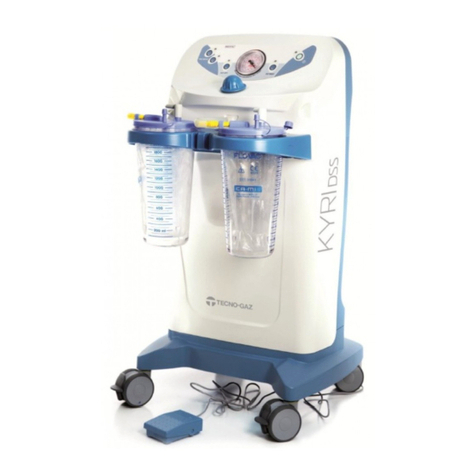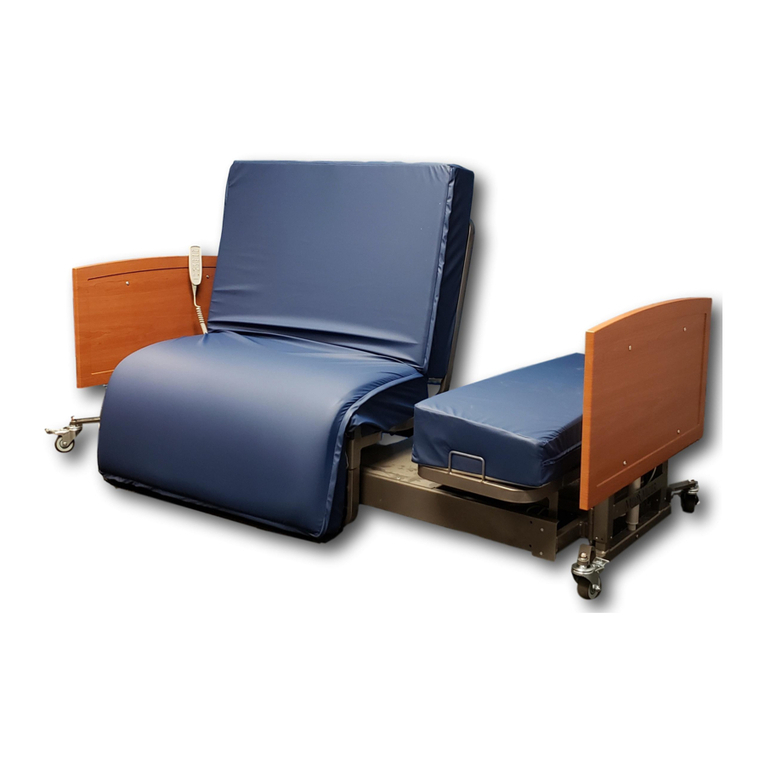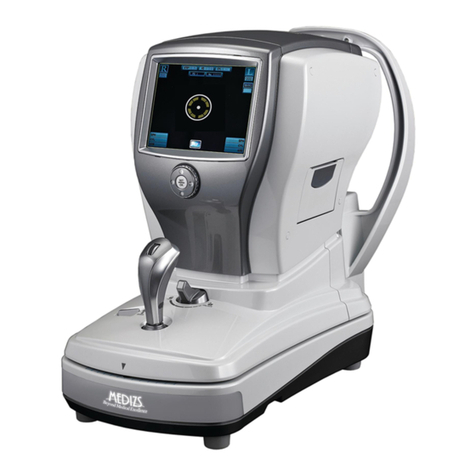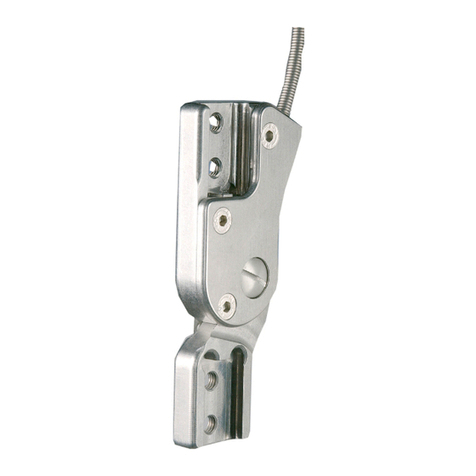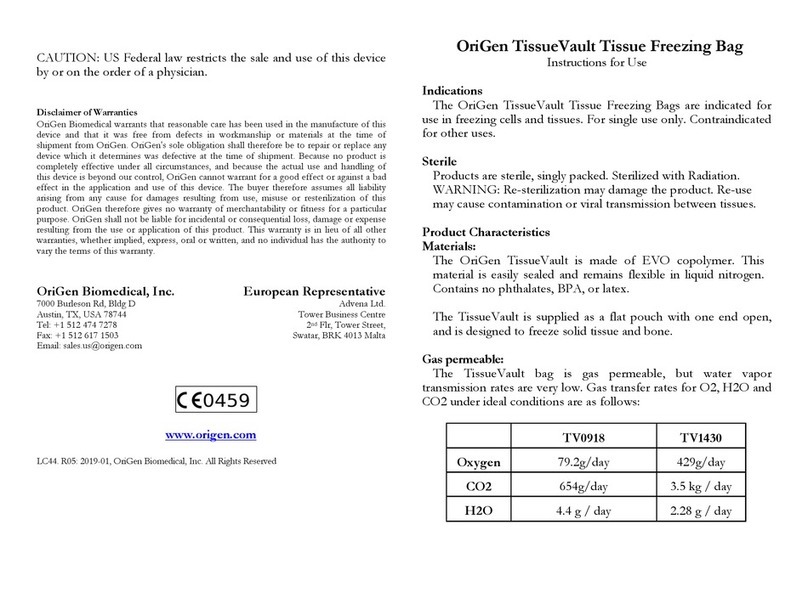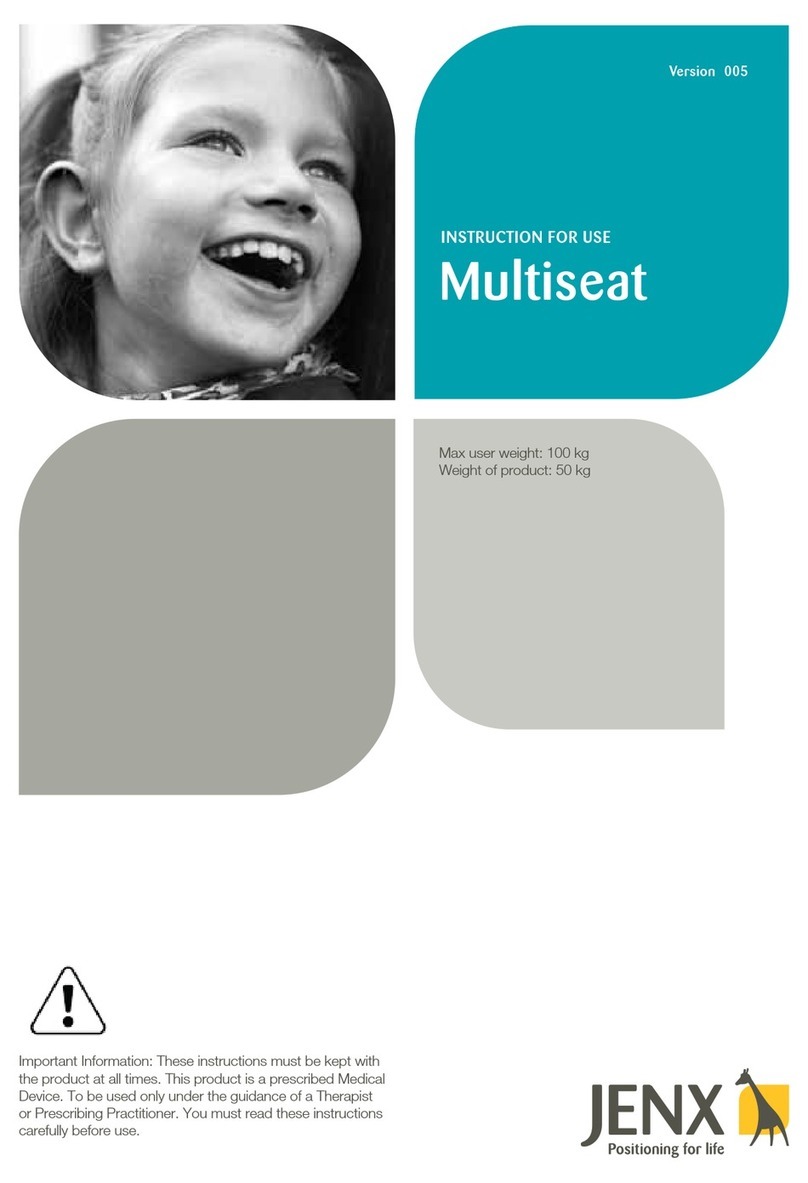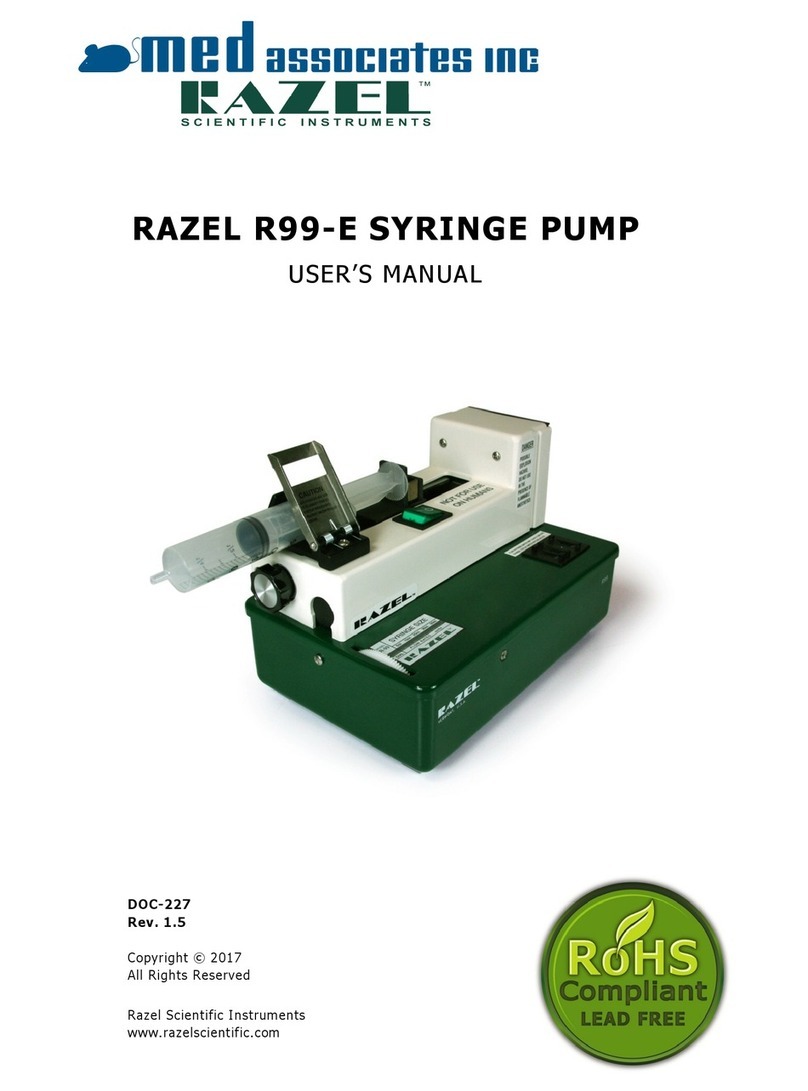CryopAL GT Series User manual

2 | GT – User manual
Copyright 2016 by Cryopal
Document code: NH78447– Revision A
November 2016 edition
English version.
Date of obtaining CE marking: 07/07/2005
Notified body: LNE GMED
All rights reserved. This document may not be reproduced in any form whatsoever, in
whole or in part, without written permission from Cryopal.
This manual complies with European Directive 93/42/EC concerning medical devices.
Cryopal
Parc Gustave Eiffel
8 Avenue Gutenberg
CS 10172 Bussy Saint Georges
F - 77607 Marne la Vallée Cedex 3
Phone: +33 (0)1 64 76 15 00
Fax: +33 (0)1 64 76 16 99
Email: [email protected] or maintenance.cryopal@airliquide.com
Website: http://www.cryopal.com
DOMINIQUE DUTSCHER SAS

3 | GT – User manual
Table of contents
Table of contents
DOMINIQUE DUTSCHER SAS

4 | GT – User manual
DOMINIQUE DUTSCHER SAS

5 | GT – User manual
1. Identity of manufacturer
The manufacturer of the GT medical device is Cryopal:
Cryopal
Parc Gustave Eiffel
8 Avenue Gutenberg
CS 10172 Bussy Saint Georges
F - 77607 Marne la Vallée Cedex 3
Phone: +33 (0)1 64 76 15 00
Fax: +33 (0)1 64 76 16 99
Email: [email protected] or maintenance.cryopal@airliquide.com
Website: http://www.cryopal.com
DOMINIQUE DUTSCHER SAS

6 | GT – User manual
2. Safety information
Before using the GT device, read this manual and the following safety instructions carefully.
2.1. General instructions
You are only authorised to operate and use the equipment mentioned in this document if you
have read through this entire manual and all safety instructions and have been trained in the
risks associated with handling cryogenic fluids.
It is recommended that a back-up liquid nitrogen tank is available at all times so that samples
may be transferred in the event of a malfunction.
The device described in this manual is designed exclusively for use by qualified personnel.
Maintenance operations should only be carried out by qualified personnel authorised by the
manufacturer. To ensure the safe and correct use of the device during service and
maintenance, it is essential that all personnel observe standard safety procedures.
In the event the cryogenic equipment does not seem to function correctly under normal
usage conditions, only someone who has been fully trained by the manufacturer is allowed to
work on the cryogenic device and its peripheral components. Users must not take action
themselves due to the health and/or safety risks. In order to avoid the loss of too much cold,
the time until the maintenance technician performs servicing must be as short as possible.
The installation of remote monitoring options or devices will improve the safety of the
cryogenic system. Regular inspections must also take place.
Important / User information ** When storing biological samples classified as sensitive by
the user, Cryopal recommends using the GT product range equipped with the temperature
and liquid nitrogen level monitoring system called Cryomemo, with the alarm transferred to a
remote video surveillance central device.
For GT devices not equipped with the Cryomemo regulation system, Cryopal recommends
the liquid nitrogen level in the device be checked continuously. The test described in section
8.3 is used to confirm that the equipment’s thermal performance is still within the
manufacturer’s recommended parameters.
DOMINIQUE DUTSCHER SAS

7 | GT –
User manual
2.2.
General precautions for use
Wear personal protective equipment (PPE) when handl
Protective
cryogenic gloves are compulsory
Fire-
resistant protective overalls (long sleeves) are re
Protective goggles are compulsory
Foot protection is recommended
/ Oxygen meter
The general precautions for use are the same for al
Liquid nitrogen is extremely cold (
contact with liquid nitrogen, especially while fill
they come into contact with the skin.
Cold burns and/or fr
On the neck and cap, after opening or while filling
By liquid nitrogen splash when opening or removing
On the lock, during or immediately after filling
On the neck and the lid after opening
Liquid nitrogen may spill out of the
User manual
General precautions for use
Wear personal protective equipment (PPE) when handl
ing the device:
cryogenic gloves are compulsory
resistant protective overalls (long sleeves) are re
commended
Protective goggles are compulsory
Foot protection is recommended
Protection
The general precautions for use are the same for al
l
cryogenic tanks:
Liquid nitrogen is extremely cold (
-
196°C). The parts of the tanks that have been in
contact with liquid nitrogen, especially while fill
ing the tanks, may cause cold burns if
they come into contact with the skin.
Cold burns and/or fr
ostbite
On the neck and cap, after opening or while filling
.
By liquid nitrogen splash when opening or removing
fittings.
On the lock, during or immediately after filling
On the neck and the lid after opening
Liquid nitrogen may spill out of the
device when handling accessories and fittings.
commended
196°C). The parts of the tanks that have been in
ing the tanks, may cause cold burns if
fittings.
device when handling accessories and fittings.
DOMINIQUE DUTSCHER SAS

8 | GT – User manual
To avoid burns, it is recommended to never touch the cold parts of the equipment
(neck, cap, tube, etc.), to prevent liquid spills by always keeping the device in an
upright position, and to always wear the personal protective equipment listed in the
safety instructions.
Trapping
By the lid when closing the device.
Crushed feet
By the casters, and the cryogenic device when handling.
Regular checks of the evaporation rate provide assurances that the product has
retained its original characteristics (see section 8.2)
Check there is no frost on the neck or outer casing of the device on a daily basis. If
there is, stop using the cryogenic device and immediately contact a member of the
maintenance team.
Check the condition of the cap (deterioration of the polystyrene, uncoupling of the
cover). If there is substantial wear and tear, replace the cap to help maintain the
device’s performance.
If liquid nitrogen drips onto the pump check valve, it may no longer be leaktight. If this
occurs, check that all traces of frost have disappeared from the neck after 24 hours.
Contact your maintenance team in the event of spillage on the valve.
It is recommended to use the device on a flat, even surface to ensure it remains
stable.
The liquid nitrogen used in the storage containers evaporates in the air: 1 litre of
liquid nitrogen releases around 700 litres of gaseous nitrogen. Nitrogen is an inert,
non-toxic gas, but it displaces oxygen when released into the atmosphere. Once the
atmospheric oxygen content falls below 19%, the human body is at risk.
All rooms and areas that house storage tanks containing liquid nitrogen should be
well ventilated at all times and equipped with at least one oxygen gauge. All
personnel should be informed of the risks associated with the use of nitrogen. Refer
to current guidelines and contact your distributor.
The device must be filled with cryogenic liquid nitrogen in a well-ventilated area
(outside) or in a room equipped with a constant ventilation system adapted to the size
of the room. The room must also be equipped with an oxygen monitoring system with
DOMINIQUE DUTSCHER SAS

9 | GT – User manual
a display located outside the room, and the user must be equipped with a portable
oxygen monitoring system.
The necessary safety conditions and the provision of safety systems for operating a
cryogenic room are the responsibility of the operator.
2.3. Precautions in the event of operating faults
Full safety cannot be guaranteed in the following cases:
The container is visibly damaged.
After prolonged storage in unsuitable conditions.
After severe damage sustained during transit.
The container loses its thermal performance.
If you suspect that the container is no longer safe (for example as a result of damage
sustained during transit or during use), it should be withdrawn from service. Make sure that
the withdrawn equipment cannot be accidentally used by others. The apparatus should be
handed over to authorised technicians for inspection.
2.4. Description of labels
DOMINIQUE DUTSCHER SAS

10 | GT –
User manual
2.5. Key to symbols
Manufacturer
Refer to the instruction
manual
Goggles must be worn
Do not touch frosted parts
User manual
Labels found on the GT device
Manufacturer
Important: Low
temperature
Refer to the instruction
Gloves must be worn
Goggles must be worn
Ventilate the room
Do not touch frosted parts
Product reference code
Important: Low
temperature
Gloves must be worn
Ventilate the room
Product reference code
DOMINIQUE DUTSCHER SAS

11 | GT –
User manual
CE marking, complies with
Directive 93/42/EC
Date of manufacture
User manual
CE marking, complies with
Directive 93/42/EC
Serial number
Date of manufacture
Capacity in litres
Serial number
Capacity in litres
DOMINIQUE DUTSCHER SAS

12 | GT –
User manual
3. GT device
3.1. Device overview
The devices in the GT
product range are unpressurised cryogenic tanks use
preserve biological specimens that have been previo
(liquid nitrogen is a cryogenic fluid).
The main features of the GT
range of devices are:
There are two ranges of
GT
-
The long holding time
through evaporation)
- The large capacity
GT
All devices in the GT
range are designed for liquid phase storage only.
GT
devices are available with user accessories as desc
The device cannot be filled automatically and is no
filling system and/or level indicator, with the exc
User manual
product range are unpressurised cryogenic tanks use
preserve biological specimens that have been previo
usly frozen in liquid nitrogen at
(liquid nitrogen is a cryogenic fluid).
range of devices are:
GT
tank:
The long holding time
GT range (neck diameter
50 mm to minimise nitrogen loss
GT
range (neck diameter
80 mm so more canisters can be used)
range are designed for liquid phase storage only.
devices are available with user accessories as desc
ribed in section
The device cannot be filled automatically and is no
t designed to accommodate a solenoid valve,
filling system and/or level indicator, with the exc
eption of the NATAL 40 (GT40 +
product range are unpressurised cryogenic tanks use
d to store and
usly frozen in liquid nitrogen at
-196°C
50 mm to minimise nitrogen loss
80 mm so more canisters can be used)
ribed in section
11.
t designed to accommodate a solenoid valve,
eption of the NATAL 40 (GT40 +
Cryomemo).
DOMINIQUE DUTSCHER SAS

13 | GT – User manual
The NATAL 40 (GT40 + Cryomemo) is equipped with a support interface for a version of
Cryomemo with temperature and level gauge.
GT devices can be equipped with a T° TRACKER temperature recorder. Caps are
designed with a concentric hole, intended for use with a temperature probe. If no probe is
used, the hole is plugged using the push rivet supplied with the cap, in order to maintain
the device’s performance.
Option to close with a standard padlock, except GT2.
Light alloy construction, for reduced weight and longer holding time.
Availability of varied storage systems adapted to vials, tubes, straws, etc.
The devices must only be used for storing products in liquid nitrogen, and not for
freezing. Any other gas is prohibited.
Cryopal recommends you always use the T° TRACKER temperature monitoring and
recording device with each cryogenic container in the GT range.
DOMINIQUE DUTSCHER SAS

14 | GT – User manual
3.2. Technical specifications
3.2.1. GT 2, 3, 9, 11, 21 and 35 - Long holding time
Manufacturers
-
Series Cryopal - GT long holding time series
Name GT2 GT3 GT9 GT11 GT21 GT35
Purpose Storing and preserving vials, straws, bags containing blood/living cells
Contraindication
Do not use outside of the temperature/humidity ranges stated in the
notice
Do not fill the tank with anything other than liquid nitrogen
Performance Maintains a cryogenic temperature to preserve biological samples
Operational
lifetime 10 years
Material held Liquid nitrogen
Tank material Aluminium alloy, epoxy fibreglass composite (neck)
Total capacity (L)1
2 3.7 9.3 12.2 21.5 33,6
Diameter of neck
(mm) 30 50 50 50 50 50
Weight when
empty (kg) 1.9 4.5 8.2 9 13 15
Weight when full
(kg) 2 3.5 7.5 15.7 19 30.4 43
Evaporation (in
L/day of liquid) 3 0.08 0.11 0.11 0.09 0.09 0,09
Warning
evaporation
(L/day)
0.24 0.33 0.33 0.27 0.27 0,27
Holding time
(days) 4 25 33 84 130 225 350
Materials in direct
or indirect contact
with the user
Aluminium alloy, epoxy fibreglass composite, polycarbonate, Klegecell
(PVC), stainless steel.
DOMINIQUE DUTSCHER SAS

15 | GT – User manual
3.2.2. GT 14, 26, 38 and 40 - Large capacity
Tanks
Cryopal
-
Large capacity series
Name
GT14
GT26
GT38
GT40
Purpose Storing and preserving vials, straws, bags containing blood/living
cells
Contraindication
Do not use outside of the temperature/humidity ranges stated in
the notice
Do not fill the tank with anything other than liquid nitrogen
Performance Maintains a cryogenic temperature to preserve biological
samples
Operational lifetime
10 years
Material held
Liquid nitrogen
Tank material Aluminium alloy + epoxy fibreglass composite (neck)
Total capacity (L)
1
13.5 26.7 37 40
Diameter of neck (mm) 80 80 80 120
Weight when empty (kg)
9.5 14.8 19 24
Weight when full (kg)
2
20.4 36 49 57
Evaporation (in L/day of
liquid) 3 0.24 0.29 0.18 0.29
Warning evaporation
(L/day) 0.72 0.87 0.54 0.87
Holding time (days)
4
56 90 205 135
Materials in direct or
indirect contact with the
user
Aluminium alloy, epoxy fibreglass composite, polycarbonate,
Klegecell (PVC), stainless steel, and expanded polystyrene for
the GT40 cap.
3.2.3. NATAL 40
The NATAL 40 product is a GT40 equipped with a Cryomemo device comprising
temperature and level gauges with remote monitoring (of temperature and level).
DOMINIQUE DUTSCHER SAS

16 | GT – User manual
3.3. Overview of the product range
References
Product description
GT2
-
1
GT2 with 3 plastic canisters
GT3
-
1
GT3 with 6 canisters and 1 plastic level
GT9
-
1
GT9 with 6 canisters and 1 plastic level
GT11
-
1
GT11 with 6 canisters and 1 plastic level
GT11
-
4
GT11 with 6 canisters and 2 plastic levels
GT21
-
1
GT21 with 6 canisters and 1 plastic level
GT21
-
4
GT21 with 6 canisters and 2 plastic levels
GT35
-
1
GT35 with 6 canisters and 1 plastic level
GT35
-
4
GT35 with 6 canisters and 2 plastic levels
GT3
-
2
GT3 with 6 canisters and 1 stainless steel level
GT9
-
2
GT9 with 6 canisters and 1 stainless steel level
GT11
-
2
GT11 with 6 canisters and 1 stainless steel level
GT11
-
3
GT11 with 6 canisters and 2 stainless steel levels
GT21
-
2
GT21 with 6 canisters and 1 stainless steel level
GT21
-
3
GT21 with 6 canisters and 2 stainless steel levels
GT35
-
2
GT35 with 6 canisters and 1 stainless steel level
GT35
-
3
GT35 with 6 canisters and 2 stainless steel levels
GT14
-
1
GT14 with 6 canisters and 1 stainless steel level
GT26
-
1
GT26 with 9 canisters and 1 stainless steel level
GT38
-
1
GT38 with 6 canisters and 2 stainless steel levels
GT40
-
1
GT40 with 10 canisters and 2 stainless steel levels
G
T
2
1
-
S
Serialized GT21 with 2 stainless steel levels
DOMINIQUE DUTSCHER SAS

17 | GT – User manual
4. Usage instructions
4.1. Intended use
Tanks in the GT range are designed for use in laboratories or hospital settings for the
preservation and storage of biological samples.
Samples could be cord blood, cells...
4.2. Expected performance
The expected performance of this device is that it maintains a cryogenic temperature for
preserving biological samples.
The -150°C temperature is guaranteed if the lid is closed, with normal filling conditions.
4.3. Device service life
The vacuum of the GT devices is guaranteed for 6 years. The service life of the GT device is
10 years under normal usage conditions.
The device’s service life can only be maintained if all of the recommendations made in this
manual are followed.
4.4. Contraindications
GT tanks must only be used within the temperature and humidity ranges specified in the user
manual, and only with liquid phase nitrogen (see section 6).
4.5. Potential adverse effects
4.5.1. User
There are two major adverse effects linked to the use of liquid nitrogen:
1. Cold burns or cryogenic burns
2. Anoxia
In order to avoid these adverse effects, follow the safety instructions provided in this manual.
DOMINIQUE DUTSCHER SAS

18 | GT – User manual
4.5.2. Device
There are two major adverse effects linked to the use of liquid nitrogen:
1. Deterioration of the cap: Wear and tear to the foam of the cap, linked to friction during
repeated opening and closing of the cap, or loosening of the cap foam.
It is recommended you have a back-up cap to use as a replacement upon the first
signs of wear and tear.
2. Leakage from the pump check valve: If liquid nitrogen drips onto the pump check
valve, it may expand and no longer be leaktight.
If liquid nitrogen spills over onto the valve, check that all traces of frost have
disappeared from the neck within 24 hours, and conduct a thermal performance
inspection of the device by following the nitrogen level inspection protocol (see section
8.2).
Figure 4-1: Example location of the pump check valve
DOMINIQUE DUTSCHER SAS

19 | GT – User manual
5. Materials used
Materials in direct
or indirect contact
with the user
Aluminium alloy, epoxy fibreglass composite, polycarbonate,
Klegecell (PVC), stainless steel, and expanded polystyrene for the
GT40 cap.
DOMINIQUE DUTSCHER SAS

20 | GT – User manual
6. Storage and handling conditions
There are several conditions and safeguards to follow so that GT devices can be used in
complete safety.
6.1. Storage
The premises in which the equipment is stored must be equipped with personal protective
equipment (PPE).
There must be minimum safety distance of 0.5 m around the device.
Do not store the equipment near heat sources.
Temperature and humidity ranges during storage (in the device’s original packaging):
- Ambient temperature: -30°C to 60°C
- Relative humidity: 0% to 85% without condensation
- Atmospheric pressure: 500 hPa to 1150 hPa
Ensure that there is sufficient ventilation in areas where liquid nitrogen is stored or used,
because liquid nitrogen evaporates and produces large quantities of nitrogen gas, which
can reduce the amount of oxygen in the surrounding air in confined spaces and lead to a
risk of anoxia. A reduction in atmospheric oxygen levels is unnoticeable when breathing
in, so anoxia results in a loss of consciousness then death without any warning signs.
An oxygen meter, linked to a powerful audio and visual indicator, must be installed near
anywhere that liquid nitrogen is stored or handled.
The device must not be stored in a small, enclosed space (such as a cabinet or closet).
The devices must be kept upright at all times.
This list is not exhaustive.
6.2. Handling
Temperature and humidity ranges during operation:
- Ambient temperature: 20°C ±5°C, away from direct sunlight
DOMINIQUE DUTSCHER SAS
This manual suits for next models
10
Table of contents
Other CryopAL Medical Equipment manuals




